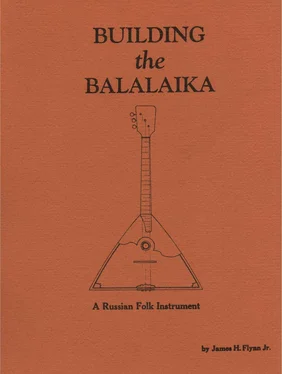James Flinn - Building the Balalaika
Здесь есть возможность читать онлайн «James Flinn - Building the Balalaika» весь текст электронной книги совершенно бесплатно (целиком полную версию без сокращений). В некоторых случаях можно слушать аудио, скачать через торрент в формате fb2 и присутствует краткое содержание. Год выпуска: 1984, ISBN: 1984, Жанр: Руководства, music, на английском языке. Описание произведения, (предисловие) а так же отзывы посетителей доступны на портале библиотеки ЛибКат.
- Название:Building the Balalaika
- Автор:
- Жанр:
- Год:1984
- ISBN:0-9613258-0-1
- Рейтинг книги:4 / 5. Голосов: 1
-
Избранное:Добавить в избранное
- Отзывы:
-
Ваша оценка:
- 80
- 1
- 2
- 3
- 4
- 5
Building the Balalaika: краткое содержание, описание и аннотация
Предлагаем к чтению аннотацию, описание, краткое содержание или предисловие (зависит от того, что написал сам автор книги «Building the Balalaika»). Если вы не нашли необходимую информацию о книге — напишите в комментариях, мы постараемся отыскать её.
Building the Balalaika — читать онлайн бесплатно полную книгу (весь текст) целиком
Ниже представлен текст книги, разбитый по страницам. Система сохранения места последней прочитанной страницы, позволяет с удобством читать онлайн бесплатно книгу «Building the Balalaika», без необходимости каждый раз заново искать на чём Вы остановились. Поставьте закладку, и сможете в любой момент перейти на страницу, на которой закончили чтение.
Интервал:
Закладка:
It is helpful to make a cardboard template like that shown in Fig. 22 to ascertain and accurately set the 2° drop of the head.
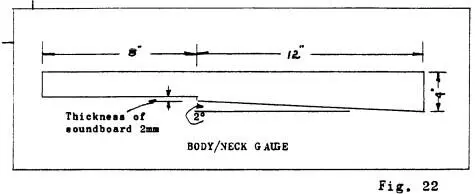
Keep in mind that if this drop is much more that 2° then an inordinately high bridge will be required to set the proper action of the strings. On the other hand, if the angle is less than 2° then the fingerboard portion which extends over the soundboard (from the 17th to the 24th frets) may interfere with the free movement of the soundboard. When all this has been ascertained, glue the head and neck assembly to the body, insert the threaded dowel into the hole in the neck and thread the bolt into it thus clamping the joint permanently. The small wedge of the neck protruding above the shoulder can now be cut off.
The Soundboard
The soundboard is the heart and soul of the balalaika in spite of many old timers from the old country calling it the belly. The vibrating strings, transmitting through the bridge, cause the soundboard to oscillate over the air in the body (soundbox) creating the peculiar and wonderous tones of the balalaika. Selection of wood for the soundboard is an important decision. For those not intending to make many instruments it is best to purchase the wood from a reputable luthiers supply house. All soundboards are quarter-sawn as shown in Fig. 4.
The highest quality of wood, which is referred to as "tone wood", is sawn from split billets. Specialists in tone woods spend a great deal of time searching out "saw logs" that show promise of cutting clear.
The logs are cut into short lengths, from 18 to 24" generally, and are split, not sawn, through the center. The rare logs are those that split straight with nary a twist, knot, pitch pocket, etc. These pieces are then split again into smaller pieces and eventually sawn into rough soundboards. When air-dried they become the top quality instrument tops. Sitka spruce (Pieca sitchensis (Bong.) Carr.), Engelmann spruce (Picea engelmannii Parry ex Sngelm.) and western redcedar (Thuja plicata Donn ex D. Don) are all excellent tone woods for soundboards . and readily available. For the prima balalaika we will need a piece 3/ 16x 8 x 24". A two-piece classical guitar top will generally fit the bill and make two balalaika soundboards. One piece is cut in half and joined to make one piece 16 x 24" with the grain running in the 12" direction. See Fig. 23 for details. Scrape and sand it to perfection without cutting it to shape. If it is cut to size first, leaving the final finishing to a later time, there is a tendency to cut the edges too low. Always sand with a sandpaper block lest small indulations in the wood appear. They will not be noticeable until after the soundboard is finished and reflected light emphasizes them. We are looking for a soundboard that will end up about 2 mm thick.
Place the soundboard on top of the body and then trace the body's outline on the soundboard. In doing this be watchful that the center seam lines up with the center of the body at both the end block and transom. Cut the soundboard to this shape. Hold it aside while we ponder what to do with it. We must plan the strut (brace) system beneath the soundboard; what sort of soundhole decoration (rosette) to use; the scheme for edge binding and purfling; the corner decorations; and, the decoration near the transom nut. These suggested decorative aspects are illustrated in Fig. 24. These patterns are typical, not absolute. For example, the soundholes of some Russian balalaikas were decorated as lodge windows. Other soundholes are merely concentric rings of contrasting woods. I strongly urge that builders design their own and let such a pattern become their "signature" on the instrument. The suggested strut design and placement are shown in Figs. 25 and 26.
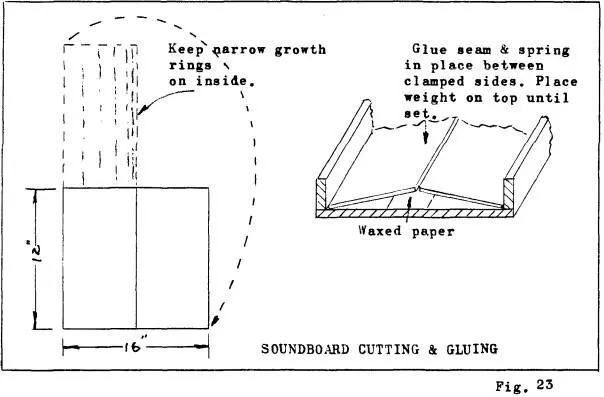
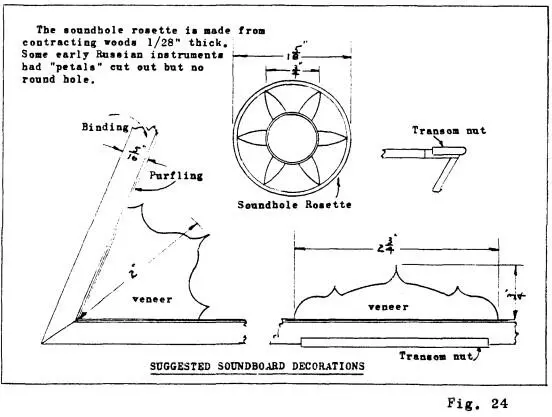
We will discuss the details of the soundboard decorations first. Drill the 5/ 4" soundhole now. This is best done with a cylindrical hole saw or a circle cutter mounted in a drill press. The best insurance for getting a sharp hole is to sandwich the soundboard between two other pieces of wood and drill all three together. (I drill my soundholes with a 7/8" Forstner pattern bit and use l/l6" walnut as an edge rim thus bringing the finished hole to 3/4".) The soundhole decoration should be made of l/28" veneer. Always cover the open-grain edge of the soundhole with a thin piece of wood. This is easily bent on a hot soldering iron and glued in place by using a tapered wood plug as a clamp. The plug is used to push the ring of wood evenly against the sides of the hole. As a matter of fact, the tool looks like a large sized version of a jewelers ring gauge.
Make a paper pattern of the soundhole design to be used. Cut the wood parts and glue these small "inlays" to the paper with a thin coat of rubber cement. When completed, lay this assembly over the center of the soundhole and scribe its outline thereon. Chisel out the soundboard so that the decoration sets flush with its surface and then glue it in place. Remove the paper which has held the part in place and level the surface of the decoration with that of the soundboard. The corner decorations and that near the transom nut are done the same way with the exception that using paper to hold the inlay is not needed because such ornamentation is usually one piece. The soundboard decorations we have just discussed can be the thickness of the soundboard. If this procedure is followed, it is wise to glue a piece of linen on the underside of the decoration to reinforce the inlay seams.
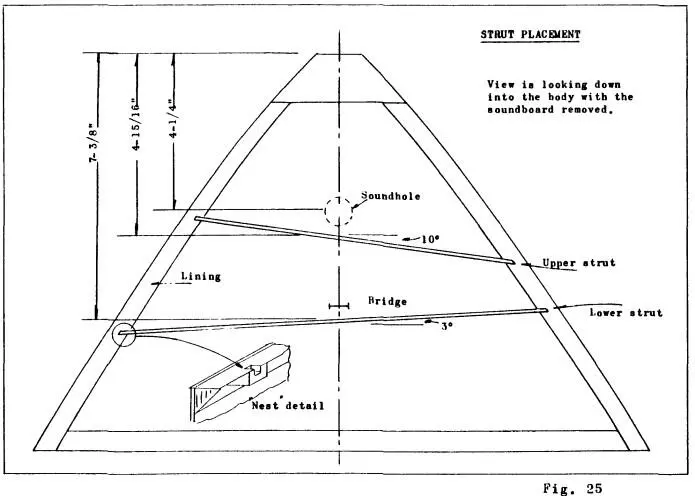
Strut design and placement is a critical part of any musical instrument with a soundboard such as the balalaika, guitar, lute, etc.
It can make or break the instrument as an effective producer of sound. There are exceptionally talented luthiers who have done a lot of painstaking experimental work on struts. It would not be possible to describe the ideal sizing and placement of struts in the balalaika because I am not sure that it is known in the West. As an "average" scheme I would like to fall back on a description of struts in a Soviet publication, by N. Prokopenko, who writes: [3] Prokopenko, N, The Construction. Preservation and Repair of Folk Musical Instruments.. Moscow, Izdatel'stro, 1977
"Two softwood braces are attached beneath the top for better flexibility. The braces divide the top into three parts. In profile the braces are wedged shaped. The highest point of each brace is in the center; they become thinner toward the ends. The ends of the braces are attached to the "nests", which are slots cut into the softwood kerfing which is attached to the upper edge of the ribs to afford a greater gluing surface for the top."
So we will work on a two-strut system placed in pockets in the side linings will full confidence that the Russian technique will produce a fine quality tonal output. Fortunately, Prokopenko provided a sketch of his two-strut system but he did not supply dimensions.
Fig. 25 is a very close approximation of his layout. Fig. 26 provides the approximate dimensions for the struts. Luthiers with other ideas on this will probably follow their own ideas, some of which may call for slanting the struts at different angles to emphasize the bass notes; not securing the ends of the struts in "nests" in the lining (probably the better way for the lower strut); stressing a variety of different shapes; etc. This work is highly endorsed and encouraged and will lead, hopefully, to the more perfect instrument. In the meantime let's let "Prokopenko struts" be the standard from which we can measure performance.
Читать дальшеИнтервал:
Закладка:
Похожие книги на «Building the Balalaika»
Представляем Вашему вниманию похожие книги на «Building the Balalaika» списком для выбора. Мы отобрали схожую по названию и смыслу литературу в надежде предоставить читателям больше вариантов отыскать новые, интересные, ещё непрочитанные произведения.
Обсуждение, отзывы о книге «Building the Balalaika» и просто собственные мнения читателей. Оставьте ваши комментарии, напишите, что Вы думаете о произведении, его смысле или главных героях. Укажите что конкретно понравилось, а что нет, и почему Вы так считаете.
